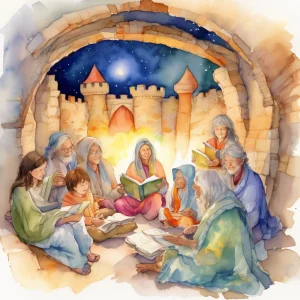Activity
Similar Activities
Enchanted Puppet Show: Creative Communication Adventure
Children’s Age: 0 month – 18 years
Activity Duration: 5 – 10 minutes
Let's have fun with the DIY Puppet Show activity! This activity helps kids improve communication skills and boosts creativity and social interaction. Gather materials like socks, g…
Activity Duration: 5 – 10 minutes
Magical Storytelling: Create Together with Friends
Children’s Age: 4–6 years
Activity Duration: 15 – 30 minutes
In the Create a Story Together activity, children will explore their creativity, language skills, and teamwork. Get small pieces of paper, colored pencils, and a container ready. K…
Activity Duration: 15 – 30 minutes
Enchanted Fort Adventures: Building a Storytime Fort
Children’s Age: 4–6 years
Activity Duration: 20 minutes
Engage children aged 48 to 72 months in the "Building a Storytime Fort" activity for a creative storytelling experience. This activity promotes adaptive and cognitive development, …
Activity Duration: 20 minutes
Enchanted Sensory Bottle Exploration for Little Ones
Children’s Age: 6 months – 1.5 years
Activity Duration: 5 minutes
Engage your child aged 6 to 18 months in a sensory bottle exploration activity to boost their communication, motor skills, and social-emotional development. Create a sensory bottle…
Activity Duration: 5 minutes
Empathy Tales: Digital Storytelling Journey
Children’s Age: 6–10 years
Activity Duration: 15 minutes
"Digital Storytelling with Empathy" is a creative activity for children aged 6 to 10, focusing on empathy, self-regulation, and language skills using digital tools. With a tablet o…
Activity Duration: 15 minutes
Vibrant Handprint Symphony - The Colorful Handprint Art
Children’s Age: 1.5–2 years
Activity Duration: 5 minutes
Engage your 18 to 24-month-old in the Colorful Handprint Art activity to support their creativity and adaptive skills. With washable non-toxic paint, white paper, and a few simple …
Activity Duration: 5 minutes
Earth's Natural Wonders: Creative Storytelling Journey
Children’s Age: 10–12 years
Activity Duration: 20 – 45 minutes
This activity is designed for children aged 10-12 to improve self-regulation and communication skills through creative storytelling about Earth's natural processes. With paper, cra…
Activity Duration: 20 – 45 minutes
Sensory Scarf Play Activity: Colors in Motion
Children’s Age: 3 – 9 months
Activity Duration: 5 minutes
The sensory scarf play activity is ideal for children aged 3 to 9 months, supporting physical development and communication skills. Set up a safe play area with soft, colorful scar…
Activity Duration: 5 minutes
Seasonal Poetry: A Language Exploration Journey
Children’s Age: 6–10 years
Activity Duration: 30 minutes
Explore the "Language Exploration Through Seasonal Poetry" activity to enhance children's communication and empathy skills through seasonal poems. Gather materials like poems, pape…
Activity Duration: 30 minutes
Musical Melodies of Healthy Lifestyle Jam Session
Children’s Age: 2–3 years
Activity Duration: 15 minutes
The Healthy Lifestyle Jam Session combines music and healthy habits for children aged 3-6 in a fun and interactive way. Gather toy musical instruments and healthy food items to cre…
Activity Duration: 15 minutes
Sensory Nature Walk: A Baby's Adventure Outdoors
Children’s Age: 0 – 6 months
Activity Duration: 10 minutes
Engage infants aged 0 to 6 months in sensory exploration with the Sensory Nature Walk activity. Gather essentials like a baby carrier, sunscreen, and soft toys for a safe outdoor e…
Activity Duration: 10 minutes
Imaginative Tales: Storytelling with a Twist
Children’s Age: 3–6 years
Activity Duration: 5 – 15 minutes
"Storytelling with a Twist" is an engaging activity designed for children aged 3 to 6 to boost self-regulation, cognitive development, and play skills. Create a cozy storytelling c…
Activity Duration: 5 – 15 minutes





























